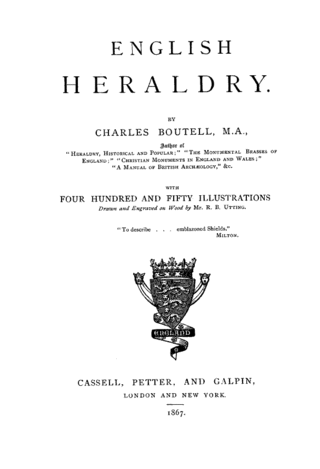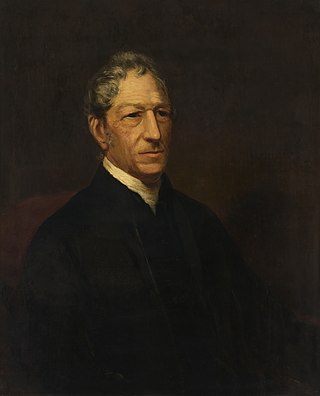
Sir George Gilbert Scott, largely known as Sir Gilbert Scott, was a prolific English Gothic Revival architect, chiefly associated with the design, building and renovation of churches and cathedrals, although he started his career as a leading designer of workhouses. Over 800 buildings were designed or altered by him.

William James Early Bennett (1804–1886) was an Anglican priest. Bennett is celebrated for having provoked the decision that the doctrine of the Real Presence is a dogma not inconsistent with the creed of the Church of England. This followed the publication of his pamphlet A Plea for Toleration in the Church of England (1867) in the form of a letter to Edward Bouverie Pusey.

James Haldane Stewart was rector of Limpsfield, Surrey, where he lies buried.

Sir Alexander Grant, 10th Baronet, FRSE was a British landowner and historian who served as Principal of the University of Edinburgh from 1868 to 1884. He had strong links to India, especially Bombay.

The Monro of Fyrish family were a Scottish family and branch of the ancient highland Clan Munro. The family produced a notable dynasty of doctors to London in the 18th and 19th century where they were involved in early work on curing 'insanity'. Four generations occupied successively the position of (Principal) Physician of the notorious Bethlem Hospital (Bedlam). They were also leading members of a variety of important medical associations. Other members were painters, priests and philanthropists of note and one was an important early patron to J. M. W. Turner.

James Buchanan (1804–1870) was a preacher and theological writer. He was born in 1804 at Paisley, and studied at the university of Glasgow. In 1827 he was ordained Church of Scotland minister of Roslin, near Edinburgh, and in 1828 he was translated to the large and important charge of North Leith. In this charge he attained great fame as a preacher, being remarkable or a clear, vigorous, and flowing style, a graceful manner, a vein of thrilling tenderness, broken from time to time by passionate appeals, all in the most pronounced evangelic strain. In 1840 Buchanan was translated to the High Church, Edinburgh, and in 1843, after the disruption, he became first minister of St. Stephen‘s Free Church. In 1845 he was appointed professor of apologetics in the New College, Edinburgh, and in 1847, on the death of Dr. Chalmers, he was transferred to the chair of systematic theology, continuing there till his resignation in 1868.

Hugo Daniel Harper was Principal of Jesus College, Oxford, from 1877 to 1895.

John Fielder Mackarness was a Church of England bishop.
Lewis Gilbertson was a Welsh clergyman and academic, who was a Fellow of Jesus College, Oxford for 32 years, rising to the position of Vice-Principal.
George Wilkins, D.D. (1785–1865) served as a priest in the Church of England and was Archdeacon of Nottingham.

Charles Boutell was an English archaeologist, antiquary and clergyman, publishing books on brasses, arms and armour and heraldry, often illustrated by his own drawings.

James Slade, (1783–1860), generally remembered as Canon Slade, was the Vicar of St Peter's Church, Bolton le Moors, Lancashire, England from 1817 to 1856.
Henry Parr Hamilton was a Scots-born clergyman and mathematician, who was Dean of Salisbury for 30 years.
The Reverend Valentine Grantham Faithfull FRSE was an English clergyman and a first-class cricketer who played for Cambridge University in 1841. He was born at Hatfield, Hertfordshire and died at Edinburgh, Scotland.
The Ven. Charles Webber, MA (1762–1848) was Archdeacon of Chichester from 1808 until his death.

William Henry Foote was an American Presbyterian minister in Virginia and North Carolina. He served as a Confederate chaplain during the American Civil War of 1861-1865. He wrote several books about the history of Presbyterians in the American South.
The Ven. George Hodson (1788–1855) was Archdeacon of Stafford from 9 May 1829 to his death from cholera at Riva del Garda on 13 August 1855.
James Leith Moody (1816–1896) was a British clergyman who served as Chaplain to the Royal Navy in China; and to the British Army in the Falkland Islands, Gibraltar, Malta, and Crimea. He was the brother of Major-General Richard Clement Moody, who was the contemporaneous first British Governor of the Falkland Islands.
Henry Hoare (1807–1866) was an English banker, a partner in Hoare's Bank. One of numerous family members of the name, he is called Henry Hoare of Staplehurst, after his Kent estate. He is now known as a lay activist for the Church of England, particularly concerned with the revival of Convocation, dormant since the early 18th century.
The Rev. George John Blomfield was an Anglican clergyman. A nephew of the Rt. Rev. Charles James Blomfield, Bishop of London, he was the father of Major-General Charles James Blomfield and Sir Reginald Blomfield.













